Report on General Electric's Acquisition of Baker Hughes Incorporated
VerifiedAdded on 2020/10/22
|10
|2291
|131
Report
AI Summary
This report examines the acquisition of Baker Hughes by General Electric, focusing on the motivations behind the merger, the evaluation of the target company using various financial metrics like PE ratio and EV/EBITDA, and the valuation of synergy. The report details the structure of the deal, including the payment method and defense strategies employed, as well as the market's reaction to the merger. It analyzes wealth transfer and creation aspects, offering a comprehensive financial analysis of the acquisition. The report concludes with an assessment of the deal's implications for both companies, drawing on financial data and market observations to provide a complete understanding of the acquisition's dynamics and outcomes.

ACQUIRING A POTENTIAL
TARGET COMPANY
TARGET COMPANY
Paraphrase This Document
Need a fresh take? Get an instant paraphrase of this document with our AI Paraphraser
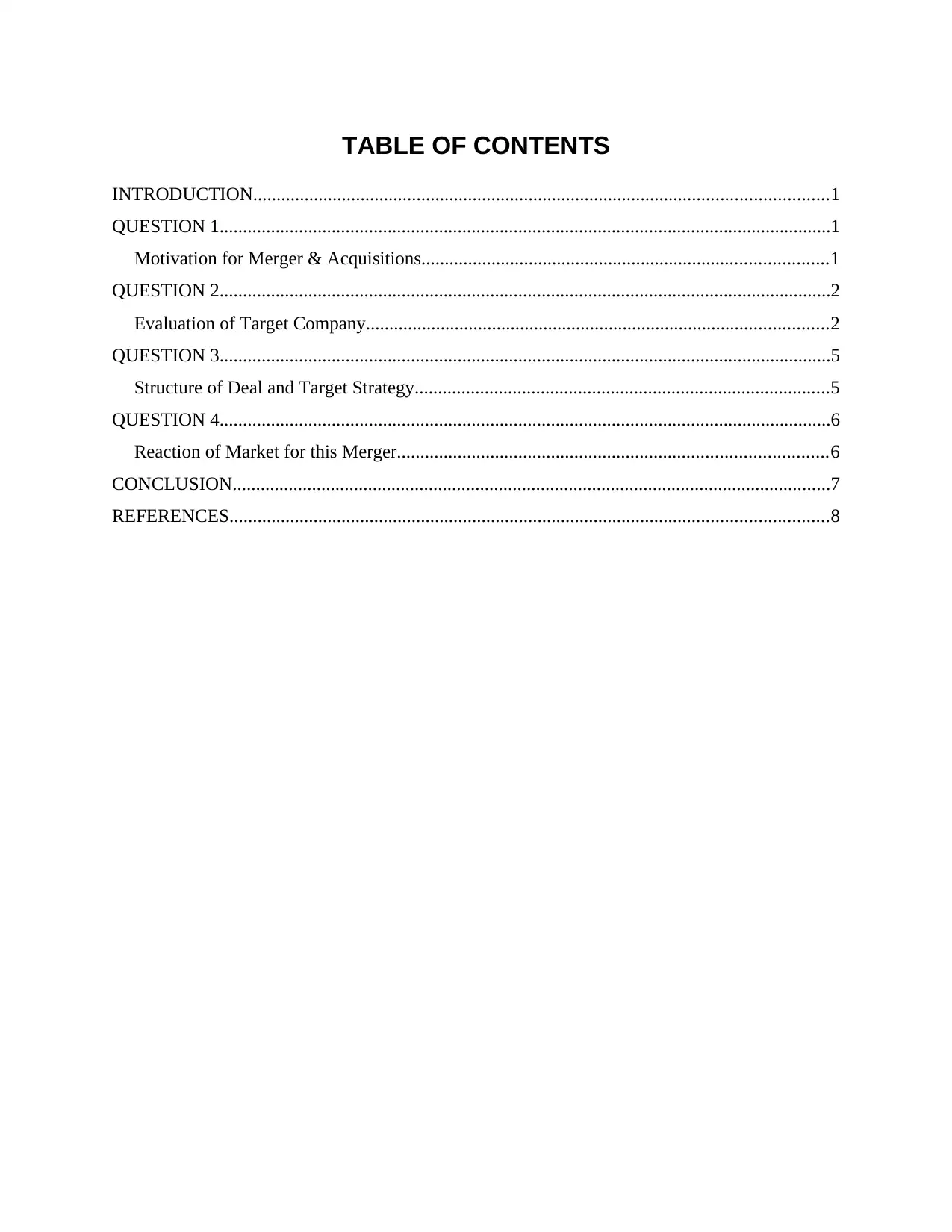
TABLE OF CONTENTS
INTRODUCTION...........................................................................................................................1
QUESTION 1...................................................................................................................................1
Motivation for Merger & Acquisitions.......................................................................................1
QUESTION 2...................................................................................................................................2
Evaluation of Target Company...................................................................................................2
QUESTION 3...................................................................................................................................5
Structure of Deal and Target Strategy.........................................................................................5
QUESTION 4...................................................................................................................................6
Reaction of Market for this Merger............................................................................................6
CONCLUSION................................................................................................................................7
REFERENCES................................................................................................................................8
INTRODUCTION...........................................................................................................................1
QUESTION 1...................................................................................................................................1
Motivation for Merger & Acquisitions.......................................................................................1
QUESTION 2...................................................................................................................................2
Evaluation of Target Company...................................................................................................2
QUESTION 3...................................................................................................................................5
Structure of Deal and Target Strategy.........................................................................................5
QUESTION 4...................................................................................................................................6
Reaction of Market for this Merger............................................................................................6
CONCLUSION................................................................................................................................7
REFERENCES................................................................................................................................8
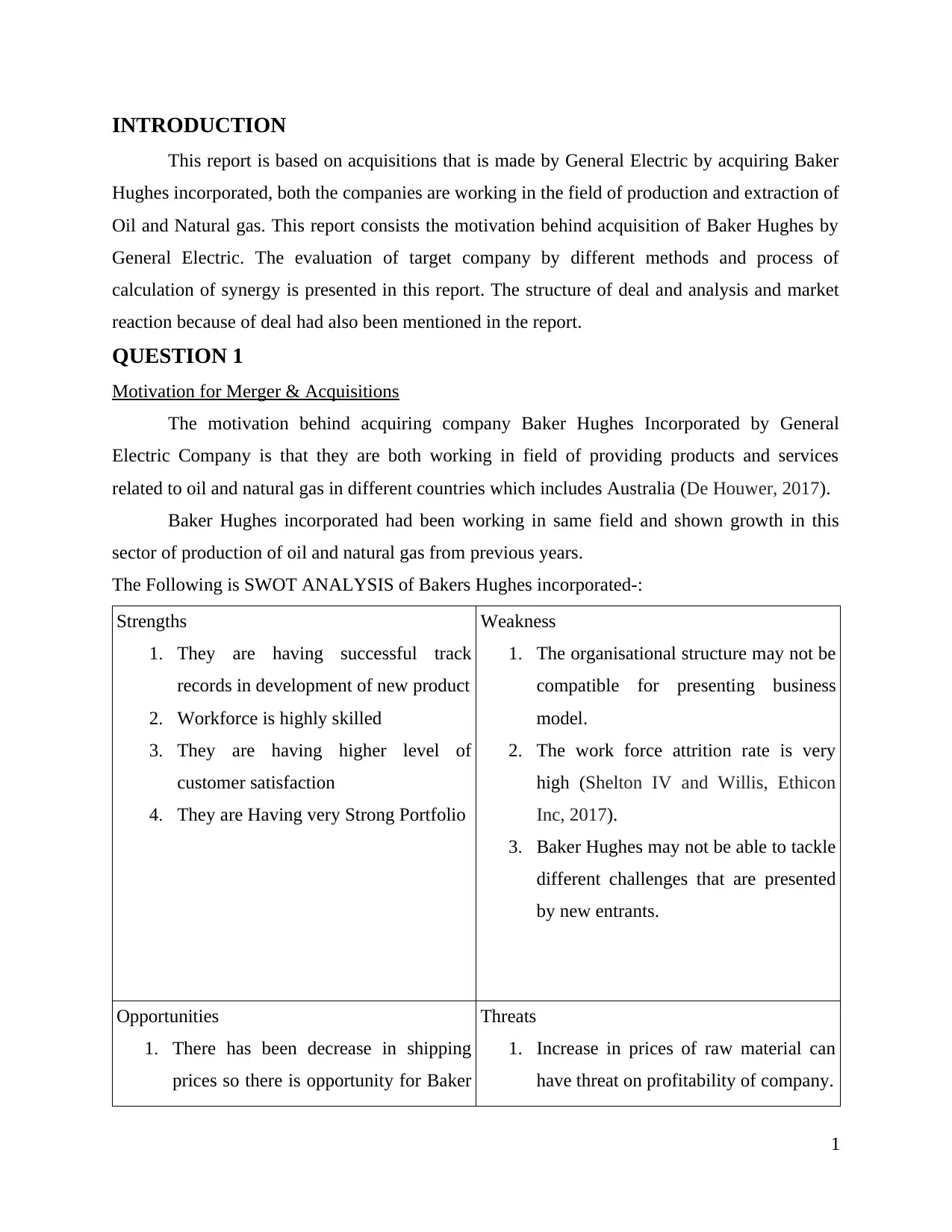
INTRODUCTION
This report is based on acquisitions that is made by General Electric by acquiring Baker
Hughes incorporated, both the companies are working in the field of production and extraction of
Oil and Natural gas. This report consists the motivation behind acquisition of Baker Hughes by
General Electric. The evaluation of target company by different methods and process of
calculation of synergy is presented in this report. The structure of deal and analysis and market
reaction because of deal had also been mentioned in the report.
QUESTION 1
Motivation for Merger & Acquisitions
The motivation behind acquiring company Baker Hughes Incorporated by General
Electric Company is that they are both working in field of providing products and services
related to oil and natural gas in different countries which includes Australia (De Houwer, 2017).
Baker Hughes incorporated had been working in same field and shown growth in this
sector of production of oil and natural gas from previous years.
The Following is SWOT ANALYSIS of Bakers Hughes incorporated-:
Strengths
1. They are having successful track
records in development of new product
2. Workforce is highly skilled
3. They are having higher level of
customer satisfaction
4. They are Having very Strong Portfolio
Weakness
1. The organisational structure may not be
compatible for presenting business
model.
2. The work force attrition rate is very
high (Shelton IV and Willis, Ethicon
Inc, 2017).
3. Baker Hughes may not be able to tackle
different challenges that are presented
by new entrants.
Opportunities
1. There has been decrease in shipping
prices so there is opportunity for Baker
Threats
1. Increase in prices of raw material can
have threat on profitability of company.
1
This report is based on acquisitions that is made by General Electric by acquiring Baker
Hughes incorporated, both the companies are working in the field of production and extraction of
Oil and Natural gas. This report consists the motivation behind acquisition of Baker Hughes by
General Electric. The evaluation of target company by different methods and process of
calculation of synergy is presented in this report. The structure of deal and analysis and market
reaction because of deal had also been mentioned in the report.
QUESTION 1
Motivation for Merger & Acquisitions
The motivation behind acquiring company Baker Hughes Incorporated by General
Electric Company is that they are both working in field of providing products and services
related to oil and natural gas in different countries which includes Australia (De Houwer, 2017).
Baker Hughes incorporated had been working in same field and shown growth in this
sector of production of oil and natural gas from previous years.
The Following is SWOT ANALYSIS of Bakers Hughes incorporated-:
Strengths
1. They are having successful track
records in development of new product
2. Workforce is highly skilled
3. They are having higher level of
customer satisfaction
4. They are Having very Strong Portfolio
Weakness
1. The organisational structure may not be
compatible for presenting business
model.
2. The work force attrition rate is very
high (Shelton IV and Willis, Ethicon
Inc, 2017).
3. Baker Hughes may not be able to tackle
different challenges that are presented
by new entrants.
Opportunities
1. There has been decrease in shipping
prices so there is opportunity for Baker
Threats
1. Increase in prices of raw material can
have threat on profitability of company.
1
⊘ This is a preview!⊘
Do you want full access?
Subscribe today to unlock all pages.

Trusted by 1+ million students worldwide
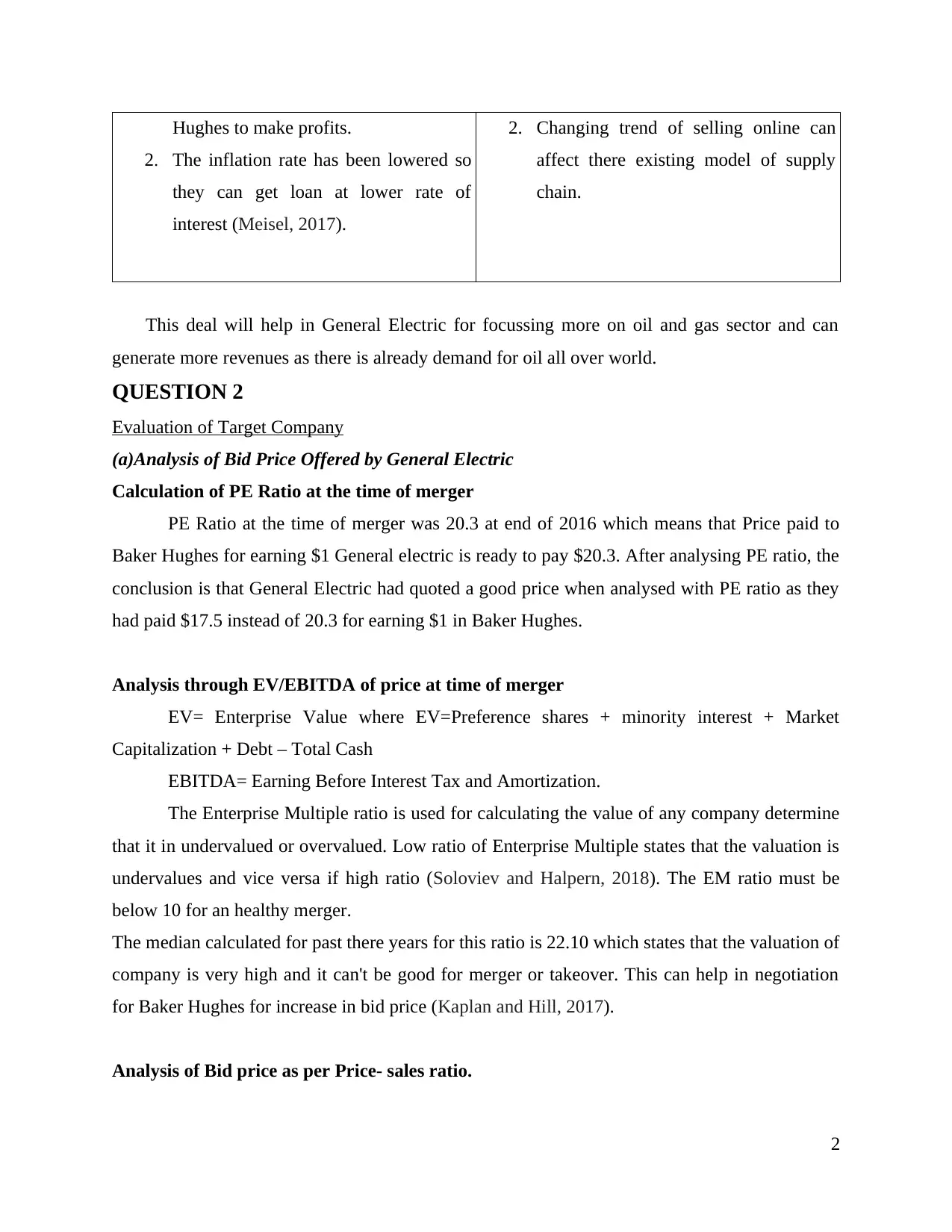
Hughes to make profits.
2. The inflation rate has been lowered so
they can get loan at lower rate of
interest (Meisel, 2017).
2. Changing trend of selling online can
affect there existing model of supply
chain.
This deal will help in General Electric for focussing more on oil and gas sector and can
generate more revenues as there is already demand for oil all over world.
QUESTION 2
Evaluation of Target Company
(a)Analysis of Bid Price Offered by General Electric
Calculation of PE Ratio at the time of merger
PE Ratio at the time of merger was 20.3 at end of 2016 which means that Price paid to
Baker Hughes for earning $1 General electric is ready to pay $20.3. After analysing PE ratio, the
conclusion is that General Electric had quoted a good price when analysed with PE ratio as they
had paid $17.5 instead of 20.3 for earning $1 in Baker Hughes.
Analysis through EV/EBITDA of price at time of merger
EV= Enterprise Value where EV=Preference shares + minority interest + Market
Capitalization + Debt – Total Cash
EBITDA= Earning Before Interest Tax and Amortization.
The Enterprise Multiple ratio is used for calculating the value of any company determine
that it in undervalued or overvalued. Low ratio of Enterprise Multiple states that the valuation is
undervalues and vice versa if high ratio (Soloviev and Halpern, 2018). The EM ratio must be
below 10 for an healthy merger.
The median calculated for past there years for this ratio is 22.10 which states that the valuation of
company is very high and it can't be good for merger or takeover. This can help in negotiation
for Baker Hughes for increase in bid price (Kaplan and Hill, 2017).
Analysis of Bid price as per Price- sales ratio.
2
2. The inflation rate has been lowered so
they can get loan at lower rate of
interest (Meisel, 2017).
2. Changing trend of selling online can
affect there existing model of supply
chain.
This deal will help in General Electric for focussing more on oil and gas sector and can
generate more revenues as there is already demand for oil all over world.
QUESTION 2
Evaluation of Target Company
(a)Analysis of Bid Price Offered by General Electric
Calculation of PE Ratio at the time of merger
PE Ratio at the time of merger was 20.3 at end of 2016 which means that Price paid to
Baker Hughes for earning $1 General electric is ready to pay $20.3. After analysing PE ratio, the
conclusion is that General Electric had quoted a good price when analysed with PE ratio as they
had paid $17.5 instead of 20.3 for earning $1 in Baker Hughes.
Analysis through EV/EBITDA of price at time of merger
EV= Enterprise Value where EV=Preference shares + minority interest + Market
Capitalization + Debt – Total Cash
EBITDA= Earning Before Interest Tax and Amortization.
The Enterprise Multiple ratio is used for calculating the value of any company determine
that it in undervalued or overvalued. Low ratio of Enterprise Multiple states that the valuation is
undervalues and vice versa if high ratio (Soloviev and Halpern, 2018). The EM ratio must be
below 10 for an healthy merger.
The median calculated for past there years for this ratio is 22.10 which states that the valuation of
company is very high and it can't be good for merger or takeover. This can help in negotiation
for Baker Hughes for increase in bid price (Kaplan and Hill, 2017).
Analysis of Bid price as per Price- sales ratio.
2
Paraphrase This Document
Need a fresh take? Get an instant paraphrase of this document with our AI Paraphraser
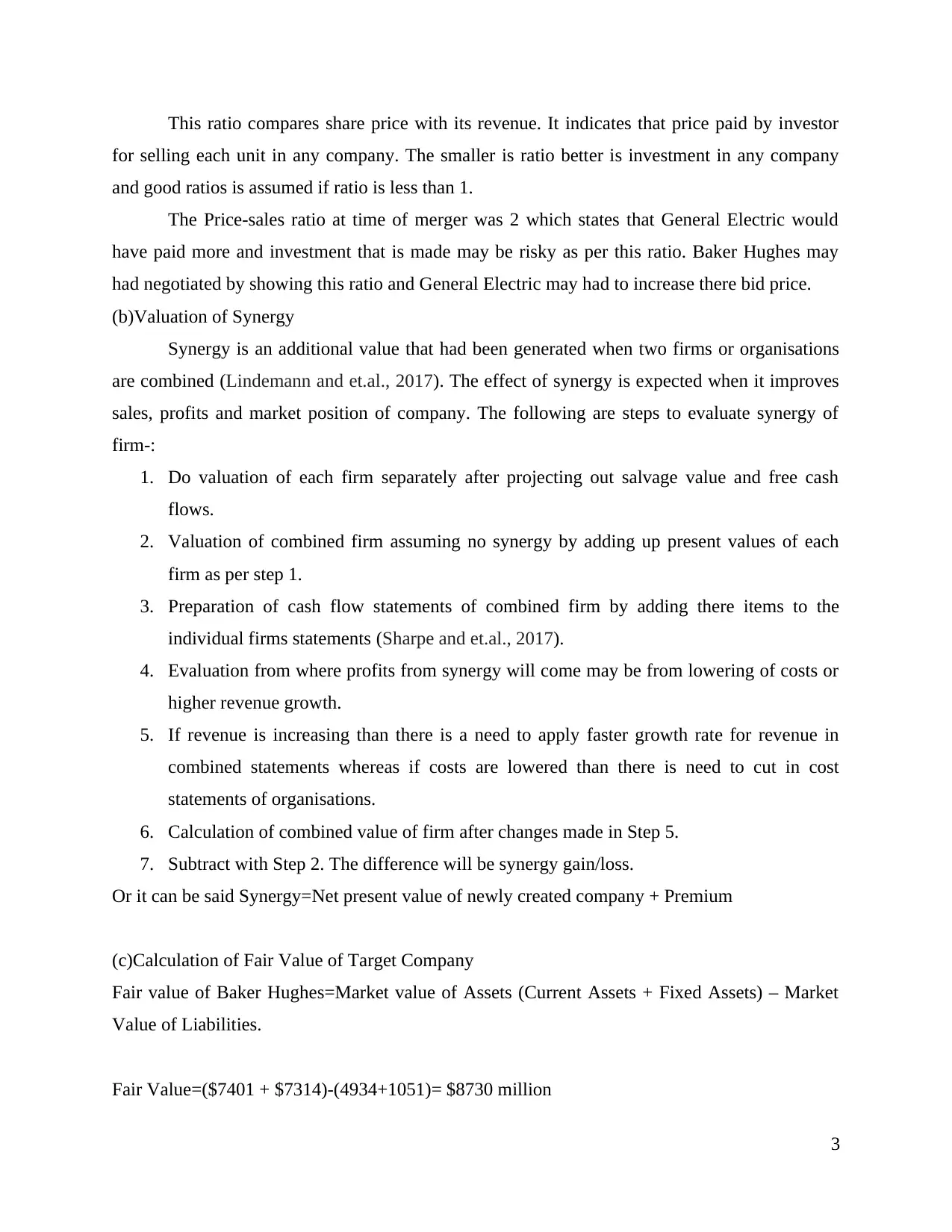
This ratio compares share price with its revenue. It indicates that price paid by investor
for selling each unit in any company. The smaller is ratio better is investment in any company
and good ratios is assumed if ratio is less than 1.
The Price-sales ratio at time of merger was 2 which states that General Electric would
have paid more and investment that is made may be risky as per this ratio. Baker Hughes may
had negotiated by showing this ratio and General Electric may had to increase there bid price.
(b)Valuation of Synergy
Synergy is an additional value that had been generated when two firms or organisations
are combined (Lindemann and et.al., 2017). The effect of synergy is expected when it improves
sales, profits and market position of company. The following are steps to evaluate synergy of
firm-:
1. Do valuation of each firm separately after projecting out salvage value and free cash
flows.
2. Valuation of combined firm assuming no synergy by adding up present values of each
firm as per step 1.
3. Preparation of cash flow statements of combined firm by adding there items to the
individual firms statements (Sharpe and et.al., 2017).
4. Evaluation from where profits from synergy will come may be from lowering of costs or
higher revenue growth.
5. If revenue is increasing than there is a need to apply faster growth rate for revenue in
combined statements whereas if costs are lowered than there is need to cut in cost
statements of organisations.
6. Calculation of combined value of firm after changes made in Step 5.
7. Subtract with Step 2. The difference will be synergy gain/loss.
Or it can be said Synergy=Net present value of newly created company + Premium
(c)Calculation of Fair Value of Target Company
Fair value of Baker Hughes=Market value of Assets (Current Assets + Fixed Assets) – Market
Value of Liabilities.
Fair Value=($7401 + $7314)-(4934+1051)= $8730 million
3
for selling each unit in any company. The smaller is ratio better is investment in any company
and good ratios is assumed if ratio is less than 1.
The Price-sales ratio at time of merger was 2 which states that General Electric would
have paid more and investment that is made may be risky as per this ratio. Baker Hughes may
had negotiated by showing this ratio and General Electric may had to increase there bid price.
(b)Valuation of Synergy
Synergy is an additional value that had been generated when two firms or organisations
are combined (Lindemann and et.al., 2017). The effect of synergy is expected when it improves
sales, profits and market position of company. The following are steps to evaluate synergy of
firm-:
1. Do valuation of each firm separately after projecting out salvage value and free cash
flows.
2. Valuation of combined firm assuming no synergy by adding up present values of each
firm as per step 1.
3. Preparation of cash flow statements of combined firm by adding there items to the
individual firms statements (Sharpe and et.al., 2017).
4. Evaluation from where profits from synergy will come may be from lowering of costs or
higher revenue growth.
5. If revenue is increasing than there is a need to apply faster growth rate for revenue in
combined statements whereas if costs are lowered than there is need to cut in cost
statements of organisations.
6. Calculation of combined value of firm after changes made in Step 5.
7. Subtract with Step 2. The difference will be synergy gain/loss.
Or it can be said Synergy=Net present value of newly created company + Premium
(c)Calculation of Fair Value of Target Company
Fair value of Baker Hughes=Market value of Assets (Current Assets + Fixed Assets) – Market
Value of Liabilities.
Fair Value=($7401 + $7314)-(4934+1051)= $8730 million
3
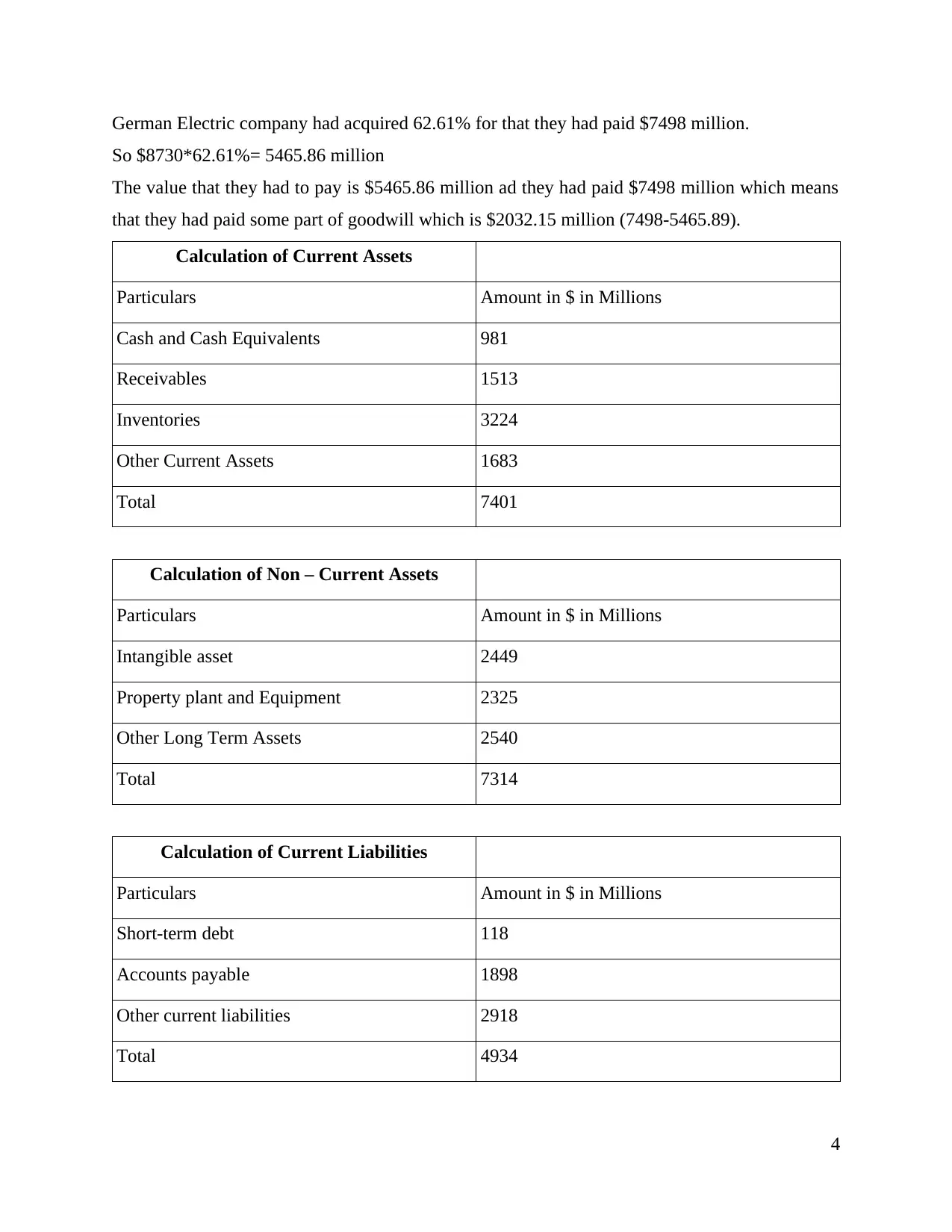
German Electric company had acquired 62.61% for that they had paid $7498 million.
So $8730*62.61%= 5465.86 million
The value that they had to pay is $5465.86 million ad they had paid $7498 million which means
that they had paid some part of goodwill which is $2032.15 million (7498-5465.89).
Calculation of Current Assets
Particulars Amount in $ in Millions
Cash and Cash Equivalents 981
Receivables 1513
Inventories 3224
Other Current Assets 1683
Total 7401
Calculation of Non – Current Assets
Particulars Amount in $ in Millions
Intangible asset 2449
Property plant and Equipment 2325
Other Long Term Assets 2540
Total 7314
Calculation of Current Liabilities
Particulars Amount in $ in Millions
Short-term debt 118
Accounts payable 1898
Other current liabilities 2918
Total 4934
4
So $8730*62.61%= 5465.86 million
The value that they had to pay is $5465.86 million ad they had paid $7498 million which means
that they had paid some part of goodwill which is $2032.15 million (7498-5465.89).
Calculation of Current Assets
Particulars Amount in $ in Millions
Cash and Cash Equivalents 981
Receivables 1513
Inventories 3224
Other Current Assets 1683
Total 7401
Calculation of Non – Current Assets
Particulars Amount in $ in Millions
Intangible asset 2449
Property plant and Equipment 2325
Other Long Term Assets 2540
Total 7314
Calculation of Current Liabilities
Particulars Amount in $ in Millions
Short-term debt 118
Accounts payable 1898
Other current liabilities 2918
Total 4934
4
⊘ This is a preview!⊘
Do you want full access?
Subscribe today to unlock all pages.

Trusted by 1+ million students worldwide
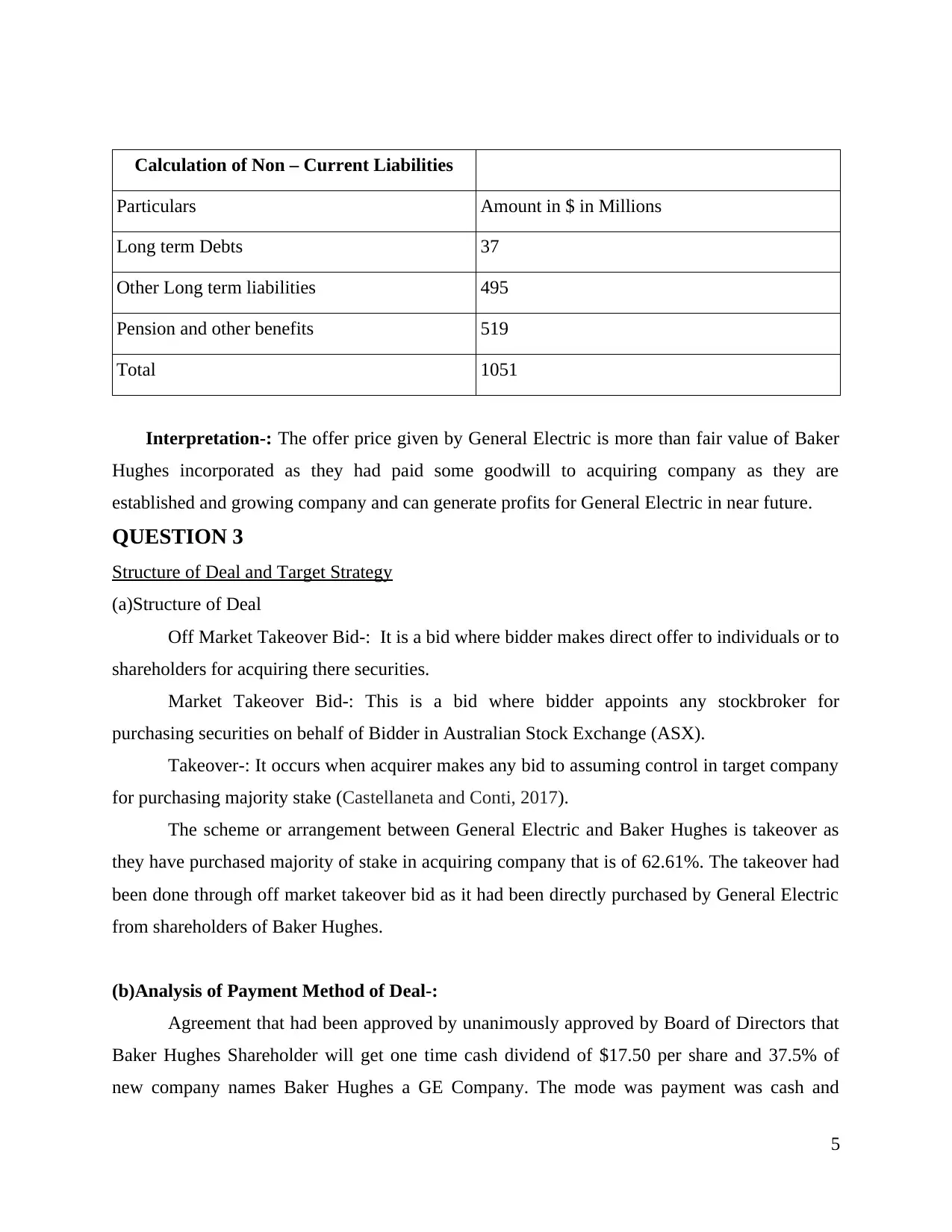
Calculation of Non – Current Liabilities
Particulars Amount in $ in Millions
Long term Debts 37
Other Long term liabilities 495
Pension and other benefits 519
Total 1051
Interpretation-: The offer price given by General Electric is more than fair value of Baker
Hughes incorporated as they had paid some goodwill to acquiring company as they are
established and growing company and can generate profits for General Electric in near future.
QUESTION 3
Structure of Deal and Target Strategy
(a)Structure of Deal
Off Market Takeover Bid-: It is a bid where bidder makes direct offer to individuals or to
shareholders for acquiring there securities.
Market Takeover Bid-: This is a bid where bidder appoints any stockbroker for
purchasing securities on behalf of Bidder in Australian Stock Exchange (ASX).
Takeover-: It occurs when acquirer makes any bid to assuming control in target company
for purchasing majority stake (Castellaneta and Conti, 2017).
The scheme or arrangement between General Electric and Baker Hughes is takeover as
they have purchased majority of stake in acquiring company that is of 62.61%. The takeover had
been done through off market takeover bid as it had been directly purchased by General Electric
from shareholders of Baker Hughes.
(b)Analysis of Payment Method of Deal-:
Agreement that had been approved by unanimously approved by Board of Directors that
Baker Hughes Shareholder will get one time cash dividend of $17.50 per share and 37.5% of
new company names Baker Hughes a GE Company. The mode was payment was cash and
5
Particulars Amount in $ in Millions
Long term Debts 37
Other Long term liabilities 495
Pension and other benefits 519
Total 1051
Interpretation-: The offer price given by General Electric is more than fair value of Baker
Hughes incorporated as they had paid some goodwill to acquiring company as they are
established and growing company and can generate profits for General Electric in near future.
QUESTION 3
Structure of Deal and Target Strategy
(a)Structure of Deal
Off Market Takeover Bid-: It is a bid where bidder makes direct offer to individuals or to
shareholders for acquiring there securities.
Market Takeover Bid-: This is a bid where bidder appoints any stockbroker for
purchasing securities on behalf of Bidder in Australian Stock Exchange (ASX).
Takeover-: It occurs when acquirer makes any bid to assuming control in target company
for purchasing majority stake (Castellaneta and Conti, 2017).
The scheme or arrangement between General Electric and Baker Hughes is takeover as
they have purchased majority of stake in acquiring company that is of 62.61%. The takeover had
been done through off market takeover bid as it had been directly purchased by General Electric
from shareholders of Baker Hughes.
(b)Analysis of Payment Method of Deal-:
Agreement that had been approved by unanimously approved by Board of Directors that
Baker Hughes Shareholder will get one time cash dividend of $17.50 per share and 37.5% of
new company names Baker Hughes a GE Company. The mode was payment was cash and
5
Paraphrase This Document
Need a fresh take? Get an instant paraphrase of this document with our AI Paraphraser
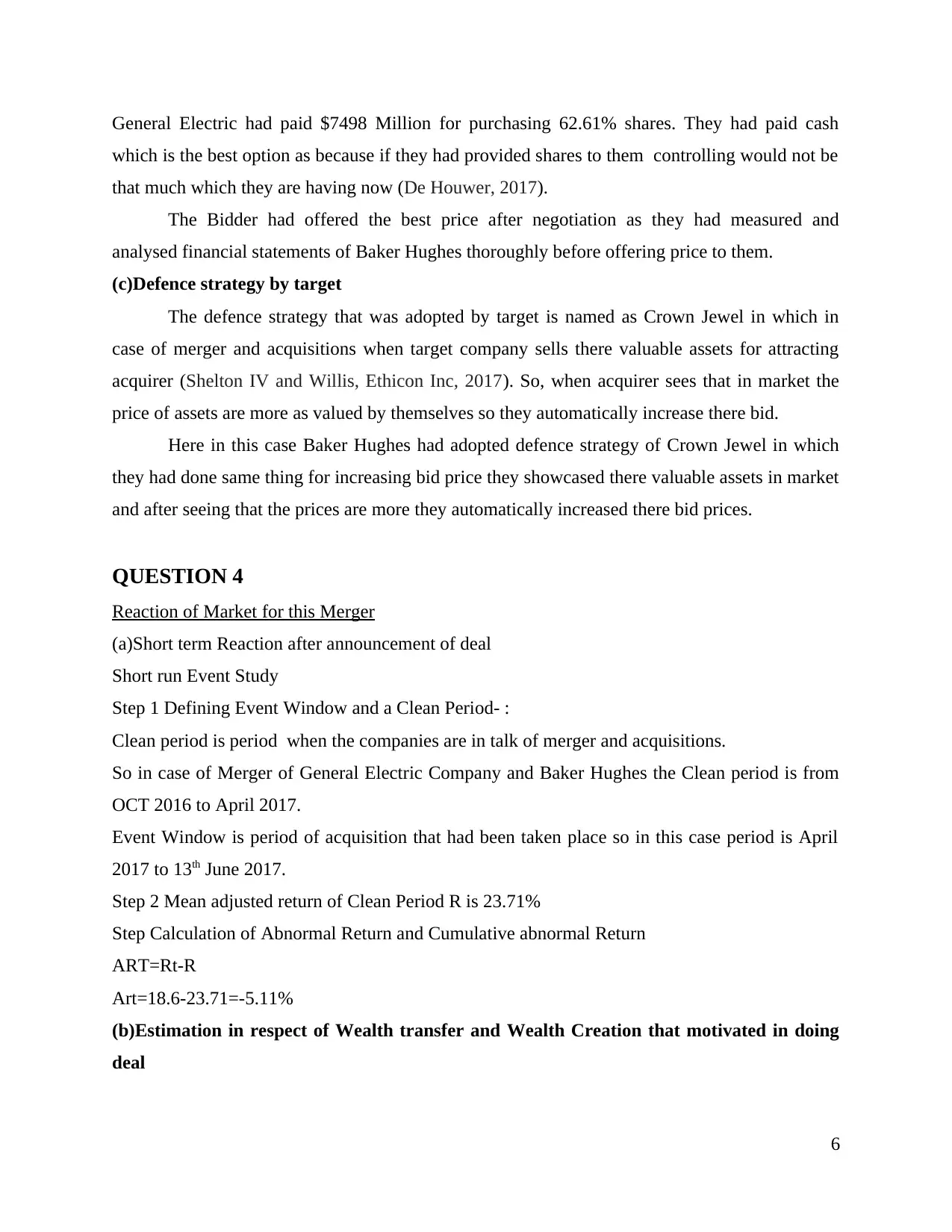
General Electric had paid $7498 Million for purchasing 62.61% shares. They had paid cash
which is the best option as because if they had provided shares to them controlling would not be
that much which they are having now (De Houwer, 2017).
The Bidder had offered the best price after negotiation as they had measured and
analysed financial statements of Baker Hughes thoroughly before offering price to them.
(c)Defence strategy by target
The defence strategy that was adopted by target is named as Crown Jewel in which in
case of merger and acquisitions when target company sells there valuable assets for attracting
acquirer (Shelton IV and Willis, Ethicon Inc, 2017). So, when acquirer sees that in market the
price of assets are more as valued by themselves so they automatically increase there bid.
Here in this case Baker Hughes had adopted defence strategy of Crown Jewel in which
they had done same thing for increasing bid price they showcased there valuable assets in market
and after seeing that the prices are more they automatically increased there bid prices.
QUESTION 4
Reaction of Market for this Merger
(a)Short term Reaction after announcement of deal
Short run Event Study
Step 1 Defining Event Window and a Clean Period- :
Clean period is period when the companies are in talk of merger and acquisitions.
So in case of Merger of General Electric Company and Baker Hughes the Clean period is from
OCT 2016 to April 2017.
Event Window is period of acquisition that had been taken place so in this case period is April
2017 to 13th June 2017.
Step 2 Mean adjusted return of Clean Period R is 23.71%
Step Calculation of Abnormal Return and Cumulative abnormal Return
ART=Rt-R
Art=18.6-23.71=-5.11%
(b)Estimation in respect of Wealth transfer and Wealth Creation that motivated in doing
deal
6
which is the best option as because if they had provided shares to them controlling would not be
that much which they are having now (De Houwer, 2017).
The Bidder had offered the best price after negotiation as they had measured and
analysed financial statements of Baker Hughes thoroughly before offering price to them.
(c)Defence strategy by target
The defence strategy that was adopted by target is named as Crown Jewel in which in
case of merger and acquisitions when target company sells there valuable assets for attracting
acquirer (Shelton IV and Willis, Ethicon Inc, 2017). So, when acquirer sees that in market the
price of assets are more as valued by themselves so they automatically increase there bid.
Here in this case Baker Hughes had adopted defence strategy of Crown Jewel in which
they had done same thing for increasing bid price they showcased there valuable assets in market
and after seeing that the prices are more they automatically increased there bid prices.
QUESTION 4
Reaction of Market for this Merger
(a)Short term Reaction after announcement of deal
Short run Event Study
Step 1 Defining Event Window and a Clean Period- :
Clean period is period when the companies are in talk of merger and acquisitions.
So in case of Merger of General Electric Company and Baker Hughes the Clean period is from
OCT 2016 to April 2017.
Event Window is period of acquisition that had been taken place so in this case period is April
2017 to 13th June 2017.
Step 2 Mean adjusted return of Clean Period R is 23.71%
Step Calculation of Abnormal Return and Cumulative abnormal Return
ART=Rt-R
Art=18.6-23.71=-5.11%
(b)Estimation in respect of Wealth transfer and Wealth Creation that motivated in doing
deal
6
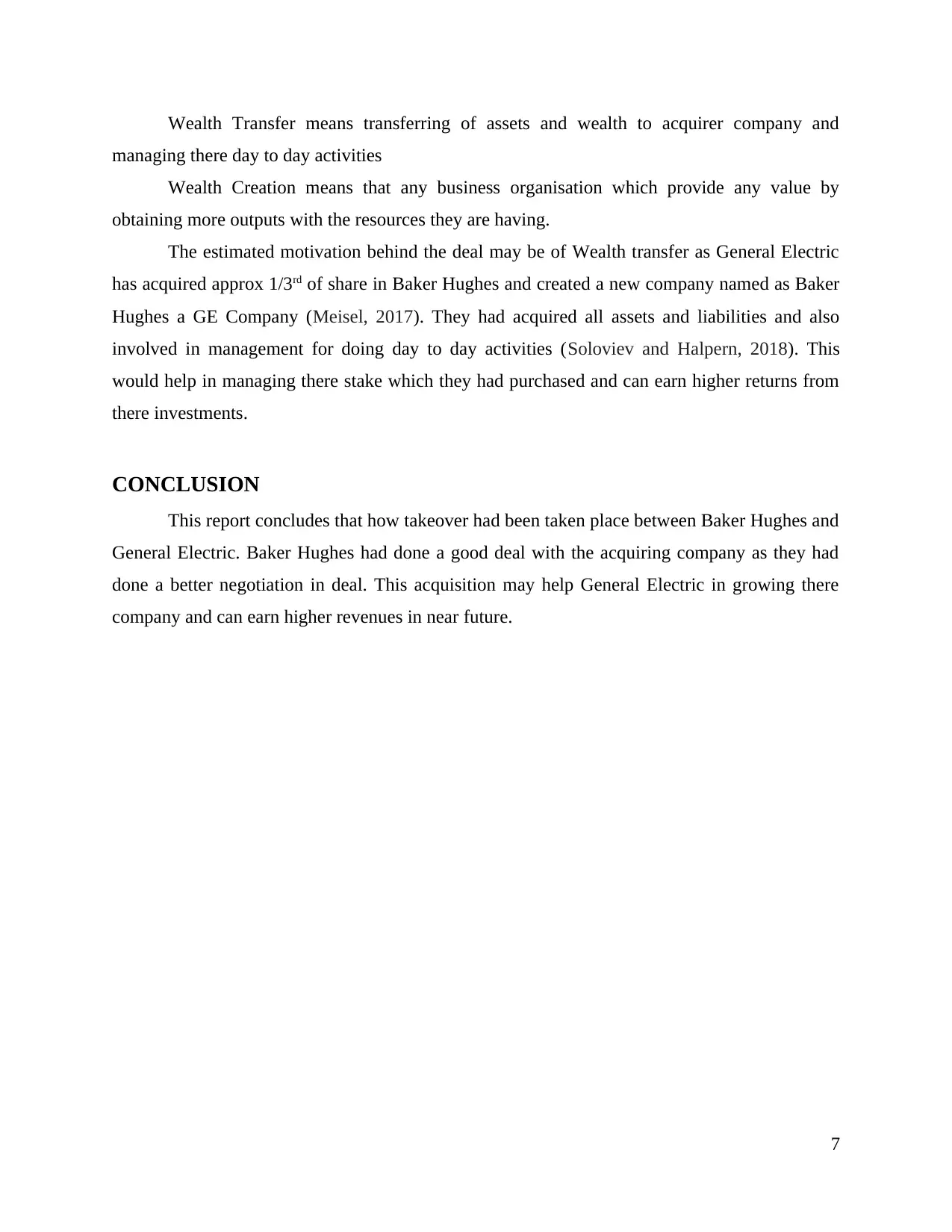
Wealth Transfer means transferring of assets and wealth to acquirer company and
managing there day to day activities
Wealth Creation means that any business organisation which provide any value by
obtaining more outputs with the resources they are having.
The estimated motivation behind the deal may be of Wealth transfer as General Electric
has acquired approx 1/3rd of share in Baker Hughes and created a new company named as Baker
Hughes a GE Company (Meisel, 2017). They had acquired all assets and liabilities and also
involved in management for doing day to day activities (Soloviev and Halpern, 2018). This
would help in managing there stake which they had purchased and can earn higher returns from
there investments.
CONCLUSION
This report concludes that how takeover had been taken place between Baker Hughes and
General Electric. Baker Hughes had done a good deal with the acquiring company as they had
done a better negotiation in deal. This acquisition may help General Electric in growing there
company and can earn higher revenues in near future.
7
managing there day to day activities
Wealth Creation means that any business organisation which provide any value by
obtaining more outputs with the resources they are having.
The estimated motivation behind the deal may be of Wealth transfer as General Electric
has acquired approx 1/3rd of share in Baker Hughes and created a new company named as Baker
Hughes a GE Company (Meisel, 2017). They had acquired all assets and liabilities and also
involved in management for doing day to day activities (Soloviev and Halpern, 2018). This
would help in managing there stake which they had purchased and can earn higher returns from
there investments.
CONCLUSION
This report concludes that how takeover had been taken place between Baker Hughes and
General Electric. Baker Hughes had done a good deal with the acquiring company as they had
done a better negotiation in deal. This acquisition may help General Electric in growing there
company and can earn higher revenues in near future.
7
⊘ This is a preview!⊘
Do you want full access?
Subscribe today to unlock all pages.

Trusted by 1+ million students worldwide
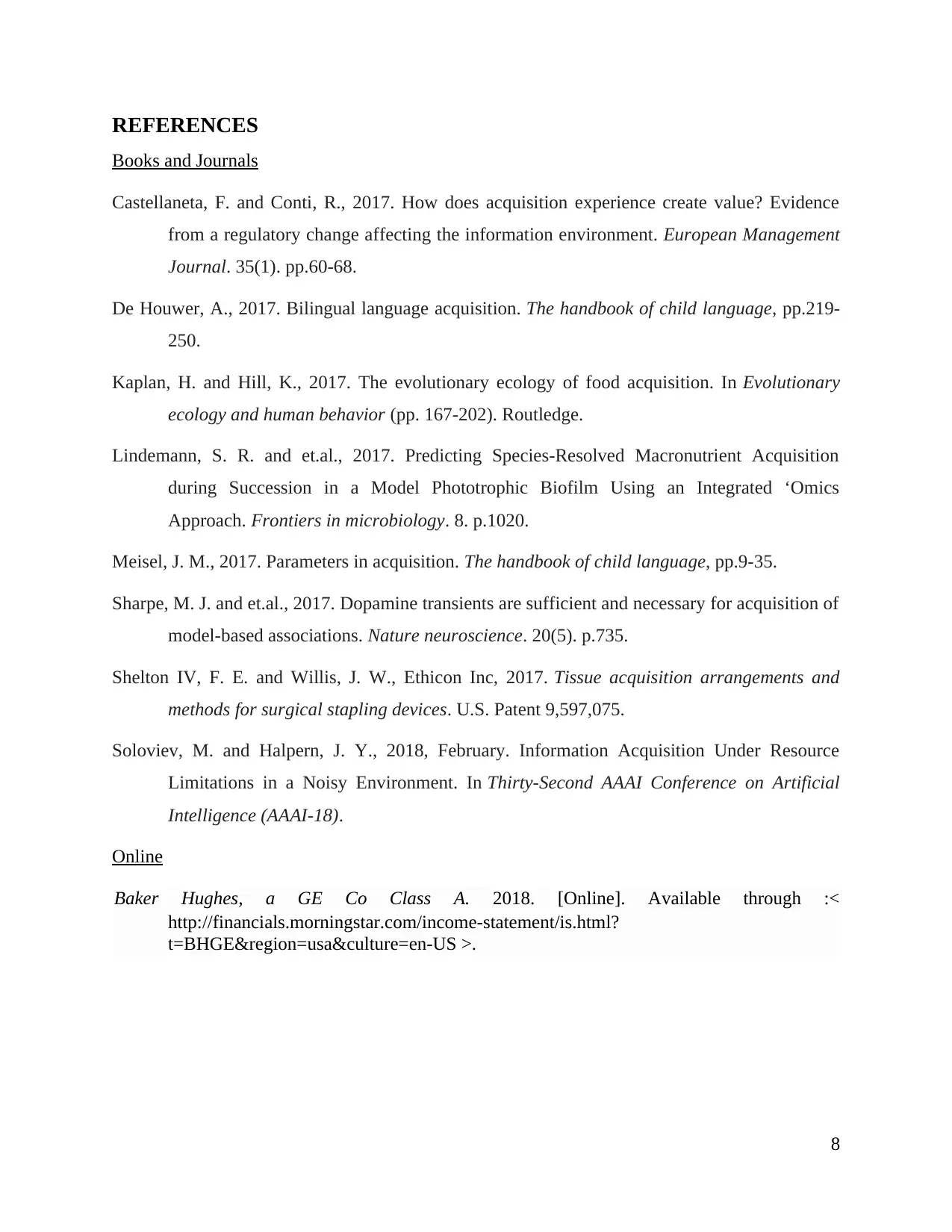
REFERENCES
Books and Journals
Castellaneta, F. and Conti, R., 2017. How does acquisition experience create value? Evidence
from a regulatory change affecting the information environment. European Management
Journal. 35(1). pp.60-68.
De Houwer, A., 2017. Bilingual language acquisition. The handbook of child language, pp.219-
250.
Kaplan, H. and Hill, K., 2017. The evolutionary ecology of food acquisition. In Evolutionary
ecology and human behavior (pp. 167-202). Routledge.
Lindemann, S. R. and et.al., 2017. Predicting Species-Resolved Macronutrient Acquisition
during Succession in a Model Phototrophic Biofilm Using an Integrated ‘Omics
Approach. Frontiers in microbiology. 8. p.1020.
Meisel, J. M., 2017. Parameters in acquisition. The handbook of child language, pp.9-35.
Sharpe, M. J. and et.al., 2017. Dopamine transients are sufficient and necessary for acquisition of
model-based associations. Nature neuroscience. 20(5). p.735.
Shelton IV, F. E. and Willis, J. W., Ethicon Inc, 2017. Tissue acquisition arrangements and
methods for surgical stapling devices. U.S. Patent 9,597,075.
Soloviev, M. and Halpern, J. Y., 2018, February. Information Acquisition Under Resource
Limitations in a Noisy Environment. In Thirty-Second AAAI Conference on Artificial
Intelligence (AAAI-18).
Online
Baker Hughes, a GE Co Class A. 2018. [Online]. Available through :<
http://financials.morningstar.com/income-statement/is.html?
t=BHGE®ion=usa&culture=en-US >.
8
Books and Journals
Castellaneta, F. and Conti, R., 2017. How does acquisition experience create value? Evidence
from a regulatory change affecting the information environment. European Management
Journal. 35(1). pp.60-68.
De Houwer, A., 2017. Bilingual language acquisition. The handbook of child language, pp.219-
250.
Kaplan, H. and Hill, K., 2017. The evolutionary ecology of food acquisition. In Evolutionary
ecology and human behavior (pp. 167-202). Routledge.
Lindemann, S. R. and et.al., 2017. Predicting Species-Resolved Macronutrient Acquisition
during Succession in a Model Phototrophic Biofilm Using an Integrated ‘Omics
Approach. Frontiers in microbiology. 8. p.1020.
Meisel, J. M., 2017. Parameters in acquisition. The handbook of child language, pp.9-35.
Sharpe, M. J. and et.al., 2017. Dopamine transients are sufficient and necessary for acquisition of
model-based associations. Nature neuroscience. 20(5). p.735.
Shelton IV, F. E. and Willis, J. W., Ethicon Inc, 2017. Tissue acquisition arrangements and
methods for surgical stapling devices. U.S. Patent 9,597,075.
Soloviev, M. and Halpern, J. Y., 2018, February. Information Acquisition Under Resource
Limitations in a Noisy Environment. In Thirty-Second AAAI Conference on Artificial
Intelligence (AAAI-18).
Online
Baker Hughes, a GE Co Class A. 2018. [Online]. Available through :<
http://financials.morningstar.com/income-statement/is.html?
t=BHGE®ion=usa&culture=en-US >.
8
1 out of 10
Related Documents
Your All-in-One AI-Powered Toolkit for Academic Success.
+13062052269
info@desklib.com
Available 24*7 on WhatsApp / Email
![[object Object]](/_next/static/media/star-bottom.7253800d.svg)
Unlock your academic potential
Copyright © 2020–2025 A2Z Services. All Rights Reserved. Developed and managed by ZUCOL.




